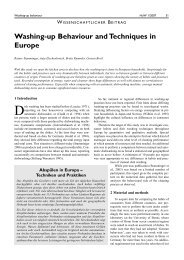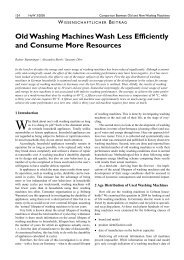Development of a novel mechatronic system for mechanical weed ...
Development of a novel mechatronic system for mechanical weed ...
Development of a novel mechatronic system for mechanical weed ...
You also want an ePaper? Increase the reach of your titles
YUMPU automatically turns print PDFs into web optimized ePapers that Google loves.
Materials and methods<br />
The drive contains a mathematical model <strong>of</strong> the whole <strong>system</strong> based on the<br />
<strong>mechanical</strong> inertia ratio <strong>of</strong> the <strong>system</strong>. The inertia ratio parameter is given as a<br />
percentage <strong>of</strong> the ratio between the inertia <strong>of</strong> the load and motor inertia. This<br />
parameter need to be properly set to optimise the speed gain.<br />
In the traditional approach, inertia ratio needs to be calculated, using the<br />
dimensions and densities <strong>of</strong> each component in the load, be<strong>for</strong>e the selection <strong>of</strong><br />
the servomotor as a decisive parameter <strong>for</strong> its sizing. The total inertia <strong>of</strong> the<br />
<strong>system</strong> is a sum <strong>of</strong> the coupling, the screw and the load inertias. However,<br />
specifications <strong>of</strong> all elements are <strong>of</strong>ten unreliable or unavailable and the<br />
complexity <strong>of</strong> the <strong>system</strong> can be a limiting factor <strong>for</strong> accurate calculation <strong>of</strong> the<br />
load inertia. The servo drive has an online auto-tuning algorithm but external<br />
factors can <strong>of</strong>ten limit its accuracy. A simple technique based on graphical<br />
analysis <strong>of</strong> the speed and torque values in the starting sequence, be<strong>for</strong>e the<br />
<strong>system</strong> reaches the steady state, can be applied. In this method the same<br />
equations are used as <strong>for</strong> motor sizing, but in reverse. The graphically<br />
determined torque and speed characteristics can be used to calculate the<br />
inertia <strong>of</strong> the load. The equation <strong>for</strong> accelerating torque calculation (Equation<br />
4.7) can be trans<strong>for</strong>med to solve it <strong>for</strong> JL (Equation 4.8)<br />
M = ( J + J ) * α<br />
(4.7)<br />
A M L<br />
MA<br />
JL = − JM<br />
(4.8)<br />
α<br />
where MA is the torque it takes to accelerate, JM is the inertia <strong>of</strong> the motor, JL is<br />
the inertia <strong>of</strong> the load and α is the actual acceleration <strong>of</strong> the motor.<br />
Typical change <strong>of</strong> the torque intensity which can cause a trapezoidal response<br />
<strong>of</strong> the speed (acceleration, constant speed and deceleration) is illustrated on<br />
the diagram in Figure 4.6.<br />
53





